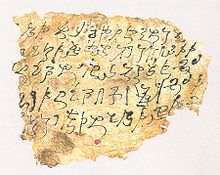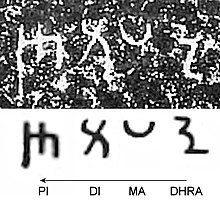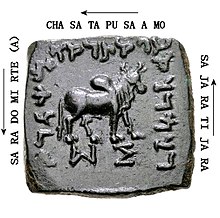
A | B | C | D | E | F | G | H | CH | I | J | K | L | M | N | O | P | Q | R | S | T | U | V | W | X | Y | Z | 0 | 1 | 2 | 3 | 4 | 5 | 6 | 7 | 8 | 9
| Kharosthi 𐨑𐨪𐨆𐨮𐨿𐨛𐨁𐨌 | |
|---|---|
 | |
| Script type | |
Time period | 4th century BCE – 3rd century CE |
| Direction | Right-to-left script |
| Languages | |
| Related scripts | |
Parent systems | |
Sister systems | |
| ISO 15924 | |
| ISO 15924 | Khar (305), Kharoshthi |
| Unicode | |
Unicode alias | Kharoshthi |
| U+10A00–U+10A5F | |

| Part of a series on |
| Numeral systems |
|---|
| List of numeral systems |
The Kharoṣṭhī script, also known as the Gāndhārī script,[6] was an ancient Indic script used by various peoples from the north-western outskirts of the Indian subcontinent (present-day Pakistan) to Central Asia via Afghanistan.[1] An abugida, it was introduced at least by the middle of the 3rd century BCE, possibly during the 4th century BCE,[7] and remained in use until it died out in its homeland around the 3rd century CE.[1]
It was also in use in Bactria, the Kushan Empire, Sogdia, and along the Silk Road. There is some evidence it may have survived until the 7th century in Khotan and Niya, both cities in East Turkestan.
History

The name Kharosthi may derive from the Hebrew kharosheth, a Semitic word for writing,[8] or from Old Iranian *xšaθra-pištra, which means "royal writing".[9] The script was earlier also known as "Indo-Bactrian script", "Kabul script" and "Arian-Pali".[10][11]
Scholars are not in agreement as to whether the Kharosthi script evolved gradually, or was the deliberate work of a single inventor. An analysis of the script forms shows a clear dependency on the Aramaic alphabet but with extensive modifications. Kharosthi seems to be derived from a form of Aramaic used in administrative work during the reign of Darius the Great, rather than the monumental cuneiform used for public inscriptions.[8] One theory suggests that the Aramaic script arrived with the Achaemenid conquest of the Indus Valley in 500 BCE and evolved over the next 200+ years to reach its final form by the 3rd century BCE where it appears in some of the Edicts of Ashoka. However, no intermediate forms have yet been found to confirm this evolutionary model, and rock and coin inscriptions from the 3rd century BCE onward show a unified and standard form. An inscription in Aramaic dating back to the 4th century BCE was found in Sirkap, testifying to the presence of the Aramaic script in present-day Pakistan. According to Sir John Marshall, this seems to confirm that Kharoshthi was later developed from Aramaic.[12]
While the Brahmi script remained in use for centuries, Kharosthi seems to have been abandoned after the 2nd–3rd century AD. Because of the substantial differences between the Semitic-derived Kharosthi script and its successors, knowledge of Kharosthi may have declined rapidly once the script was supplanted by Brahmi-derived scripts, until its re-discovery by Western scholars in the 19th century.[8]
The Kharosthi script was deciphered separately almost concomitantly by James Prinsep (in 1835, published in the Journal of the Asiatic society of Bengal, India)[13] and by Carl Ludwig Grotefend (in 1836, published in Blätter für Münzkunde, Germany),[14] with Grotefend "evidently not aware" of Prinsep's article, followed by Christian Lassen (1838).[15] They all used the bilingual coins of the Indo-Greek Kingdom (obverse in Greek, reverse in Pali, using the Kharosthi script). This in turn led to the reading of the Edicts of Ashoka, some of which were written in the Kharosthi script (the Major Rock Edicts at Mansehra and Shahbazgarhi).[8]
The study of the Kharosthi script was recently invigorated by the discovery of the Gandhāran Buddhist texts, a set of birch bark manuscripts written in Kharosthi, discovered near the Afghan city of Hadda just west of the Khyber Pass in Pakistan. The manuscripts were donated to the British Library in 1994. The entire set of British Library manuscripts are dated to the 1st century CE, although other collections from different institutions contain Kharosthi manuscripts from 1st century BCE to 3rd century CE,[16][17] making them the oldest Buddhist manuscripts yet discovered.
Characteristics
This article needs additional citations for verification. (June 2019) |


Kharosthi (𐨑𐨪𐨆𐨮𐨿𐨛𐨁𐨌, from right to left Kha-ro-ṣṭhī) is mostly written right to left (type A).
Each syllable includes the short /a/ sound by default[citation needed], with other vowels being indicated by diacritic marks. Recent epigraphic evidence[citation needed] has shown that the order of letters in the Kharosthi script follows what has become known as the Arapacana alphabet. As preserved in Sanskrit documents, the alphabet runs:[citation needed]
- a ra pa ca na la da ba ḍa ṣa va ta ya ṣṭa ka sa ma ga stha ja śva dha śa kha kṣa sta jñā rtha (or ha) bha cha sma hva tsa gha ṭha ṇa pha ska ysa śca ṭa ḍha
Some variations in both the number and order of syllables occur in extant texts.[citation needed]
Kharosthi includes only one standalone vowel character, which is used for initial vowels in words.[citation needed] Other initial vowels use the a character modified by diacritics. Using epigraphic evidence, Salomon has established that the vowel order is /a e i o u/, akin to Semitic scripts, rather than the usual vowel order for Indic scripts /a i u e o/. Also, there is no differentiation between long and short vowels in Kharosthi. Both are marked using the same vowel markers.
The alphabet was used in Gandharan Buddhism as a mnemonic for remembering a series of verses on the nature of phenomena. In Tantric Buddhism, the list was incorporated into ritual practices and later became enshrined in mantras.
Vowels
| Initial | Diacritic | ||||||||
|---|---|---|---|---|---|---|---|---|---|
| Image | Text | Trans. | IPA | Image | Text | With 'k' | |||
| Unrounded | low central | 𐨀 | a | /ə/ | — | — | 𐨐 | ka | |
| high front | 𐨀𐨁 | i | /i/ | 𐨁 | 𐨐𐨁 | ki | |||
| Rounded | high back | 𐨀𐨂 | u | /u/ | 𐨂 | 𐨐𐨂 | ku | ||
| Syllabic vibrant | 𐨃 | 𐨐𐨃 | kr̥ | ||||||
| Mid | front unrounded | 𐨀𐨅 | e | /e/ | 𐨅 | 𐨐𐨅 | ke | ||
| back rounded | 𐨀𐨆 | o | /o/ | 𐨆 | 𐨐𐨆 | ko | |||
| Vowel | Position | Example | Applies to |
|---|---|---|---|
| -i | horizontal | 𐨀 + 𐨁 → 𐨀𐨁 | a, n, h |
| diagonal | 𐨐 + 𐨁 → 𐨐𐨁 | k, ḱ, kh, g, gh, c, ch, j, ñ, ṭ, ṭh, ṭ́h, ḍ, ḍh, ṇ, t, d, dh, b, bh, y, r, v, ṣ, s, z | |
| vertical | 𐨠 + 𐨁 → 𐨠𐨁 | th, p, ph, m, l, ś | |
| -u | attached | 𐨀 + 𐨂 → 𐨀𐨂 | a, k, ḱ, kh, g, gh, c, ch, j, ñ, ṭ, ṭh, ṭ́h, ḍ, ḍh, ṇ, t, th, d, dh, n, p, ph, b, bh, y, r, l, v, ś, ṣ, s, z |
| independent | 𐨱 + 𐨂 → 𐨱𐨂 | ṭ, h | |
| ligatured | 𐨨 + 𐨂 → 𐨨𐨂 | m | |
| -r̥ | attached | 𐨀 + 𐨃 → 𐨀𐨃 | a, k, ḱ, kh, g, gh, c, ch, j, t, d, dh, n, p, ph, b, bh, v, ś, s |
| independent | 𐨨 + 𐨃 → 𐨨𐨃 | m, h | |
| -e | horizontal | 𐨀 + 𐨅 → 𐨀𐨅 | a, n, h |
| diagonal | 𐨐 + 𐨅 → 𐨐𐨅 | k, ḱ, kh, g, gh, c, ch, j, ñ, ṭ, ṭh, ṭ́h, ḍ, ḍh, ṇ, t, dh, b, bh, y, r, v, ṣ, s, z | |
| vertical | 𐨠 + 𐨅 → 𐨠𐨅 | th, p, ph, l, ś | |
| ligatured | 𐨡 + 𐨅 → 𐨡𐨅 | d, m | |
| -o | diagonal | 𐨀 + 𐨆 → 𐨀𐨆 | a, k, ḱ, kh, g, gh, c, ch, j, ñ, ṭ, ṭh, ṭ́h, ḍ, ḍh, ṇ, t, th, d, dh, n, b, bh, m, r, l, v, ṣ, s, z, h |
| vertical | 𐨤 + 𐨆 → 𐨤𐨆 | p, ph, y, ś |
Consonants
| Voiceless Plosives | Voiced Plosives | Nasals | ||||||||||||||||
|---|---|---|---|---|---|---|---|---|---|---|---|---|---|---|---|---|---|---|
| Unaspirated | Aspirated | Unaspirated | Aspirated | |||||||||||||||
| Image | Text | Trans. | IPA | Image | Text | Trans. | Image | Text | Trans. | IPA | Image | Text | Trans. | Image | Text | Trans. | IPA | |
| Velar | 𐨐 | k | /k/ | 𐨑 | kh | 𐨒 | g | /ɡ/ | 𐨓 | gh | ||||||||
| Palatal | 𐨕 | c | /c/ | 𐨖 | ch | 𐨗 | j | /ɟ/ | 𐨙 | ñ | /ɲ/ | |||||||
| Retroflex | 𐨚 | ṭ | /ʈ/ | 𐨛 | ṭh | 𐨜 | ḍ | /ɖ/ | 𐨝 | ḍh | 𐨞 | ṇ | /ɳ/ | |||||
| Dental | 𐨟 | t | /t/ | 𐨠 | th | 𐨡 | d | /d/ | 𐨢 | dh | 𐨣 | n | /n/ | |||||
| Labial | 𐨤 | p | /p/ | 𐨥 | ph | 𐨦 | b | /b/ | 𐨧 | bh | 𐨨 | m | /m/ | |||||
There are two special modified forms of these consonants:[20]
| Image | Text | Trans. | Image | Text | Trans. | |
|---|---|---|---|---|---|---|
| Modified form | 𐨲 | ḱ | 𐨳 | ṭ́h | ||
| Original form | 𐨐 | k | 𐨛 | ṭh |
